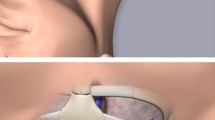Abstract
An audit of 151 central venous catheters (CVCs) in 118 children with malignant disease was carried out over 20 months. The types included 31 valved silastic (Groshong), 58 non-valved silastic (Hickman), and 62 non-valved polyurethane (Cuff Cath) CVCs. There was no difference between the three groups with regard to the clinical diagnosis. The mean patient age at catheter insertion was 5.5 years and the mean weight 21.6 kg. None of the catheter types were associated with an increased risk of problems at insertion, migration, mechanical damage, blockage, sampling, or catheter infection. The incidence of catheter infection was 1.4/1,000 catheter days. Exit-site infection was less frequent with Groshong CVCs (P <0.05), which were in situ for the shortest period. The risk of problems with blood sampling was significantly increased in those catheters whose tip was sited outside the right atrium (P <0.005). For the 60 CVCs removed electively, the mean duration in situ was similar for all catheter types; 43 were removed following a problem. Of these, Groshong catheters were in situ for the shortest period (P = 0.05), probably as a result of delayed anchoring of the cuff. The tip position was the single most important determinant in the correct functioning of CVCs, irrespective of the type of catheter. Intraoperative screening of the tip position at catheter insertion is therefore mandatory for optimal catheter functioning.
Similar content being viewed by others
References
Alfieres GM, Wing CN, Hoy GR (1987) Securing Broviac catheters in children. Pediatr Surg 22: 825–826
Becton DL, Kletzel M, Gollady DS, Hathaway G, Berry DH (1988) An experience with an implantable port system in 66 children with cancer. Cancer 61: 376–378
Cairo MS, Spoone S, Sowdwn L, Bennetts GA, Towne B, Hodder F (1986) Long term use of indwelling multipurpose silastic catheters in paediatric cancer patients treated with aggressive chemotherapy. J Clin Oncol 4: 784–788
Camp LD (1988) Care of the Groshong catheter. Oncol Nurs Forum 15: 745–749
Clarke J, Cox E (1988) Heparinisation of Hickman catheters. Nurs Times 84: 51–53
Dawson S, Pai MY, Smith S, Rothney M, Ahmed K, Barr RD (1991) Right atrial catheters in children with cancer: a decade of experience in the use of tunnelled exteriorised devices at a single institution. Am J Pediatr Hematol Oncol 13: 126–129
Decker MD, Edwards KM (1988) Central venous catheter infections. Pediatr Clin North Am 35: 579–612
Delmore JE, Horbelt DV, Jack BL, Roberts DK (1989) Experience with the Groshong long-term central venous catheter. Gynecol Oncol 34: 216–218
Elliot TSJ (1988) Intravascular device infections. J Med Microbiol 27: 161–167
Fraschini G, Jadeja J, Lawson M, Holmes FA, Carrisco HC, Wallace S (1987) Local infusion of urokinase for the lysis of thrombosis associated with permanent central venous catheters in cancer patients. J Clin Oncol 5: 672–678
Gibilisco PA, Lopez GA, Appleman MD, Millburg WJ, Kuskell DL, Elowitz L, Johnson PA, Zenowich D (1986) In vitro contamination of ‘piggyback/heparin lock’ assemblies: prevention of contamination with a closed, positive locking device (Click-Lock). J Parent Enteral Nutr 10: 431–434
Hickman RO, Buckner CD, Clift RA, Sander JE, Stewart P, Thomas ED (1979) A modified right atrial catheter for access to the venous system in bone marrow transplant patients. Surg Gynecol Obstet 148: 871–875
Holocombe J, Forloines-Lynn S, Garmhausen LW (1992) Restoring patency of long term venous access devices. J Intraven Nurs 15: 36–41
Hurtubise RM, Bottino CJ, Lawson M, McCredie KB (1980) Restoring patency of occluded central venous catheters. Arch Surg 115: 212–213
Ingram J, Weitzman S, Greenberg ML, Parkin P, Filler R (1991) Complications of indwelling venous access lines in pediatric hematology patients. A prospective comparison of external venous catheters and subcutaneous ports. Am J Pediatr Hematol Oncol 13: 130–136
La Quaglia MP, Lucas A, Thaler HT, Friedlander-Klar H, Exelby PR, Groeger JS (1992) A prospective analysis of vascular access device-related infections in children. J Pediatr Surg 27: 840–842
Linder L-E, Curelaru J, Gustavsson B, Hansson H-A, Stenqvist O, Wojciechowski J (1984) Material thrombogenicity in central venous catheterisation: a comparison between soft, antebrachial catheters of silicone elastomer and polyurethane. J Parent Enteral Nutr 8: 399–406
Mirro J, Rao BN, Stokes DC, Austin BA, Kumar M, Dahl GV, Colten M, Balas M, Rafferty M, Hancock M (1989) A prospective study of Hickman/Broviac catheters and implantable ports in pediatric oncology patients. J Clin Oncol 7: 214–222
Moran BJ, Sutton GL, Karran SJ (1992) Clinical evaluation of percutaneous insertion and long term usage of a new cuffed polyurethane catheter for central venous access. Ann R Coll Surg Engl 16: 1–4
Pesse ME, Howard RJ (1985) Complications of Hickman/Broviac catheters. Surg Gynaecol Obstet 161: 257–260
Scott WL (1988) Complications associated with central venous catheters: a survey. Chest 94: 1221–1224
Thomas S, Davis C, Murray H, Schutz S, Sherriff B, Wood K (1992) Skin tunnelled catheters: guidelines for care. Roy Coll N Publ 7: 1–17
Wheeler RA, Griffiths DM (1992) Cuff Cath: an initial experience of cuffed polyurethane central venous catheters in children. J Parent Enteral Nutr 16: 384–385
Wheeler RA, Griffiths DM, Burge DM (1992) The retrograde tunnel: a method for the fixation of long term paediatric central venous catheters. J Parent Enteral Nutr 15: 275–279
Wurzel CL, Halom K, Feldman JG, Rubin LG (1988) Infection rates of Broviac-Hickman catheters and implantable venous devices. Am J Dis Child 142: 536–540
Author information
Authors and Affiliations
Rights and permissions
About this article
Cite this article
Lucas, H., Attard-Montalto, S.P., Saha, V. et al. Central venous catheter tip position and malfunction in a paediatric oncology unit. Pediatr Surg Int 11, 159–163 (1996). https://doi.org/10.1007/BF00183753
Accepted:
Published:
Issue Date:
DOI: https://doi.org/10.1007/BF00183753




